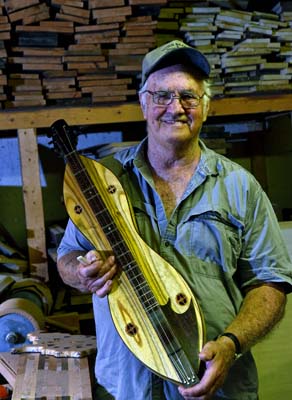2017 Vandalia Recipient
Jim Good
By Adam Booth

Dulcimer maker Jim Good. Photo by Adam Booth.
“Well, one evening, I was going home from work cleaning carpet, and I come around a little alley up in Weston. I’m a nosey person, and I wanted to see what was around. And there was an old man sitting on the front porch, playing the dulcimer.”
I’m sitting with Jim and Brenda Good in their two-story workshop, just outside Walton in Roane County. The first floor brims with stacks of varied wood. Each pile is in a different stage of being turned into a dulcimer, a cutting board, or another creation. Tools of many shapes and sizes rest near each workstation. The three of us warm ourselves around a woodstove fed by sawdust, a byproduct of their work process. Jim talks about how he started building instruments, beginning with that fateful trip down a Weston alley over four decades ago.
“I’d never seen a dulcimer. Never heard of one. I listened to that old man play and, boy, that sound—slow and easy!”
That slow-and-easy music is what drives Jim to build the best-sounding highest-quality Appalachian dulcimers available. In his previous career, Jim spent 25 years in the carpet business. He was on complaint duty for several years and learned an important lesson: do it right the first time.
Brenda comments, “Rather than have dissatisfied customers, we take the time to make sure it’s right and a good product.”
Hearing that man in Weston play a dulcimer gave Jim an idea: “I had a neighbor up the road who had a woodworking shop in his attic.” Jim smiles and leans back in his chair, closer to the stove, almost in disbelief of his own memory. “I asked him about dulcimers, and he said he’d help me make one.”
That was in 1973. Before that, Jim hadn’t even been a woodworker. Within a year, he had learned to play the dulcimer and was building them to sell under the brand name Mastertone Dulcimers. The Goods’ dulcimers are made in the traditional West Virginia style, with a gently curved hourglass figure. Each features carefully selected woods, a bookmatched back (giving it that mirrored open-book look), pearlized inlay dots, and walnut shells for sound holes. Although each instrument is visually striking, the Goods’ dulcimers stand out for their tone and unique G major open tuning. While Jim is considered the driving craftsperson, Brenda contributes much to the process, including stringing, tuning, and helping cure the woods.
Jim and Brenda tend to date their dulcimers based on a family calamity: before and after the fire. Jim recalls, “In 1983 our house, shop, and everything in it burned down. After that, we went back to work, and I started putting metal keys in them. Everything was wooden keys before that, like violin pegs.”
If you happen to come across a pre-fire Mastertone Dulcimer, note details like a hand-carved scroll, a perimeter of pearlized inlay work, or a stylistic lip, where the top and bottom parts hang over the side walls.
In addition to the pre- and post-1983 variations, Mastertone is well-known for its archtop model. Most dulcimer makers patch together various pieces of wood to make the resonating soundbox. Jim, however, hand-carves the top and bottom of the archtop body from a single piece of wood. The body style looks more like a fine violin or cello, with details more reminiscent of an artisan wooden bowl found at a craft fair. In fact, he got the idea for an archtop while exhibiting at a fair.
Because the required tools make it difficult to demonstrate dulcimer making on location, Jim’s primary way of marketing instruments had been to play them for potential customers. “I was out there at a show and playing one of my dulcimers,” says Jim. “This lady who ran the show came up to me and said, ‘Mr. Good, you know, you’re supposed to demonstrate.’”
In retelling the story, Jim pauses briefly. His sense of humor is sometimes disguised by his ability to edit his thoughts.
He replied to the woman, boyishly, “Well, I’ve heard that.”
While her comment was a bit of a rebuke, it sparked Jim’s imagination. By carving archtops, he could make dulcimers just about anywhere and with only a few tools. The revelation changed his career. Fairgoers loved to watch him craft beautiful instruments right there in his booth. Plus, it gave his instruments a style that contrasted distinctly with most other dulcimers.
Jim takes great pride in his work: “What I try to do is make an instrument that people can play. Old-fashioned dulcimers weren’t very good. People made them out of hog troughs and screws and other different things. They had a reputation for being simple instruments that weren’t well-made.”
Over the years, the Goods’ dulcimers have been juried into many craft fairs, such as the Augusta Heritage Festival in Elkins and the Mountain Heritage Arts and Crafts Festival in Jefferson County. In 1996, the Goods were inducted into the Mountain State Art and Craft Fair Hall of Fame in Jackson County. In 2017, Jim Good was honored with our state’s highest folklife honor, the Vandalia Award, which pays tribute to Jim’s “creativity, ingenuity, and talent.”
You can read the rest of this article in this issue of Goldenseal, available in bookstores, libraries or direct from Goldenseal.